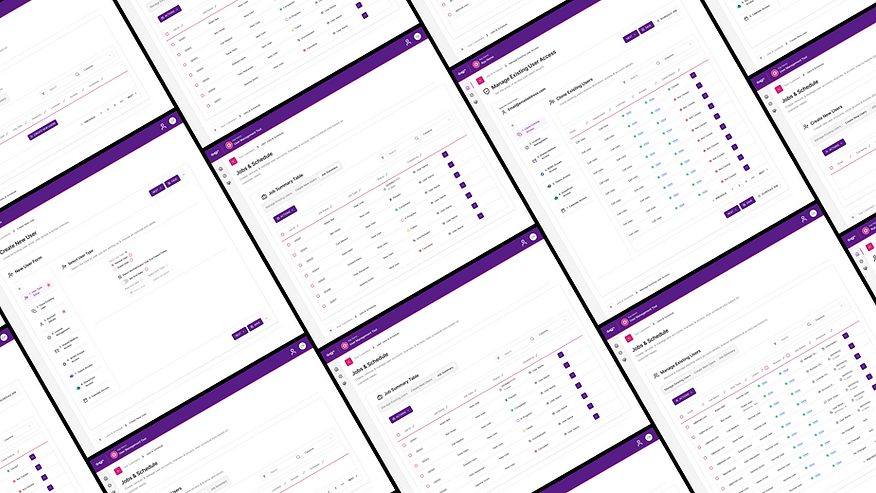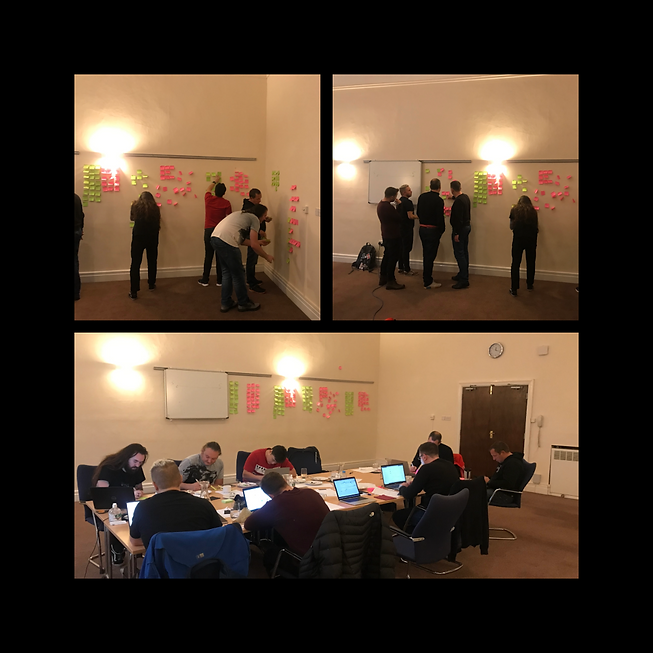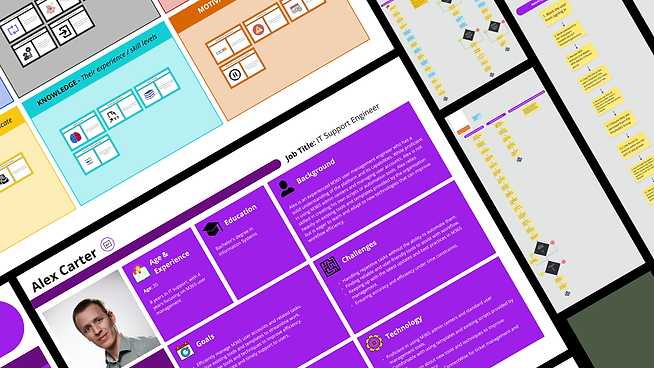User management tool
As Lead UX Designer at a software company supporting SMB Managed Service Providers (MSPs), I led the UX strategy, research, and design for a tool aimed at automating routine user management tasks. The company also operated as an MSP, offering a real-world testing ground for validating new software ideas to help MSPs scale efficiently.
The goal of the UMT project was to streamline tasks like onboarding new users, managing permissions, and updating account information—freeing up engineers to focus on more complex, high-value service requests.


A mini Overview
Problem Statement
Who is affected by the problem?
Support engineers working in Managed Service Providers (MSPs), and MSP business leaders aiming to scale operations and reduce overhead.
What is the problem?
Engineers are overwhelmed by repetitive user management tasks—such as onboarding, permission updates, and account changes—leading to inefficiencies, diverted focus from complex service requests, and barriers to business scalability.
Where & When does this problem occur?
This occurs daily within MSP service desks, particularly when managing high volumes of user management tickets across multiple client accounts. The problem becomes more pronounced during onboarding periods or high staff turnover within client organisations.
Why does it exist, and why does it matter?
Current workflows require engineers to perform time-consuming, manual tasks that follow predictable patterns but lack automation support.
-
Valuable engineering time is spent on low-value, repeatable actions.
-
It delays responses to higher-priority tickets and impacts customer satisfaction.
-
Growing the business requires hiring more engineers, increasing costs and reducing profit margins.
Without automation, MSPs struggle to scale efficiently. Manual handling of routine tickets slows service delivery, reduces operational effectiveness, and limits revenue potential.

my role
As Lead UX Designer on the UMT project, I was responsible for shaping the product from strategy through to MVP delivery.
My role spanned:
-
Strategic planning
-
User research
-
Design execution
-
Useability testing
-
Developer handover
1.1 Strategy overview
The UMT originated from a strategic initiative aligned with the company’s five-year growth plan: to reduce reliance on support engineers for routine user management tasks and to develop a scalable SaaS solution for the MSP market.
I contributed to strategic planning sessions, helping to define how the UMT could support this goal by lowering the ticket volume handled by engineers and enabling them to focus on higher-value service work. My involvement ensured the product vision aligned with both operational efficiency and long-term commercial growth.
As part of the strategy phase, the release approach for the UMT was defined and structured into three phases.

1.2 Strategy Takeaways
1. Aligning UX with Business Strategy
Being part of the business leadership team and contributing to the development of the one- and five-year plans gave me the opportunity to explore how UX planning can align with broader business objectives. It deepened my understanding of how design decisions can support long-term scalability and revenue growth, and strengthened my ability to communicate the value of UX to non-design stakeholders.
2. Product Vision Collaboration
Working closely with leadership during strategic planning taught me how to shape and clarify a product vision, balancing technical feasibility, user needs, and commercial opportunities.
3. Planning for Scalable Design
Having a clear vision for the UMT as a future SaaS product influenced my early thinking around system design, modularity, and interface consistency. It also pushed me to optimise my workflow to meet tight deadlines within a fast-paced, ambitious business run by a small, focused team.
4. Shaping a phased Release Strategy
Helping define a phased release approach taught me how to map user needs and technical complexity to a realistic rollout plan, ensuring each phase delivered meaningful value while staying achievable for development.

2.1 Research Overview
I led the user research process, which included the following:
Competitive benchmarking
To identify best practices in similar tools
Depth interviews
With support engineers to uncover pain points, goals, workflows, and user expectations
Process mapping
To visualise current workflows related to onboarding, permission setting, and user changes
Identify Processes
For both standardised and non-standardised user management processes
Define ticket scenarios
For the core UMT ticket scenarios and steer the MVP functionality requirements
Identify edge cases
To surface edge cases and complexity in workflow variance
Empathy maps & Persona
To summarise user insights
Key functional requirements list
Presented to the leadership team to secure alignment before moving into design.
2.2 research Takeaways
1. Deepening Empathy Through Contextual Research
Interviews with support engineers revealed the real pressures of their day-to-day workflows. A key insight was that ticket requests often arrived well in advance of the required action, creating task pile-ups on specific days. This led to the inclusion of a job scheduler feature, allowing engineers to assign future tasks immediately—preventing backlogs and improving efficiency. Insights like this grounded the design in real user needs.
2. Prioritising Features for Impact
Collaborating with engineers to map workflows helped distinguish core functionality from edge cases—critical for shaping a focused MVP. While stakeholders initially pushed for bespoke workflow creation, research showed most user management tasks followed four standard patterns: User Creation, Access Permissions, Account Modification & Licence Management, and User Removal. These became the foundation of the MVP, ensuring development effort delivered the most value.
3. Turning Research into Actionable Artefacts
I transformed interview insights into empathy maps, proto-personas, and a functional requirements document. These artefacts clarified user needs and helped stakeholders connect features—like job scheduling and templates—to real pain points. Presenting the requirements list, tied directly to user insights, shifted stakeholder discussions from assumptions to evidence, enabling faster alignment on MVP scope.
3.1 Design overview
I designed the UMT’s end-to-end experience through:
User journey maps
For key scenarios like account creation, permission management, and removal
User flows
to define intuitive interactions for each core function
Creation of Figma-based design system
Following Atomic Design principles to ensure modularity, reusability, and visual consistency across the SaaS suite
Usability Testing
Throughout, I conducted user testing with target engineer personas, iterating the interface and flows based on feedback until we achieved a polished MVP experience.

3.2 design Takeaways
1. Designing for Real-World Use Cases
Mapping user journeys for scenarios like account creation and user removal helped me visualise the full experience across touchpoints—from the engineer to the customer. This process highlighted gaps in the current workflows, such as missing confirmation steps and permission clarity, which I then addressed through improved UI flow and system feedback elements in the design.
2. Building a Scalable, Consistent Design System
As this product was part of a growing suite of SaaS tools, the existing design system was no longer fit for purpose. Too many custom components had been created over time, slowing down both design and development while fragmenting the user experience.
I created a new design system that adhered more closely to Atomic Design principles, ensuring visual and functional consistency across screens. This also streamlined developer handoff, as the system doubled as a reference library for UI behaviour and logic.
The new system significantly accelerated my workflow by focusing on flexible base components for screens, sheets, and forms—each structured with instance replacement slots that allowed more granular content to be added quickly and consistently.
3. Turning Research into Actionable Artefacts
I transformed interview insights into empathy maps, proto-personas, and a functional requirements document. These artefacts clarified user needs and helped stakeholders connect features—like job scheduling and templates—to real pain points. Presenting the requirements list, tied directly to user insights, shifted stakeholder discussions from assumptions to evidence, enabling faster alignment on MVP scope.
4. Iterating Through User Feedback
Regular usability testing with engineers helped me refine the interface based on real user behaviour. For example, initial testers struggled to locate certain permission settings, which led me to simplify the navigation hierarchy and improve labelling. This iterative process ensured we reached an MVP that felt intuitive and efficient for everyday use.